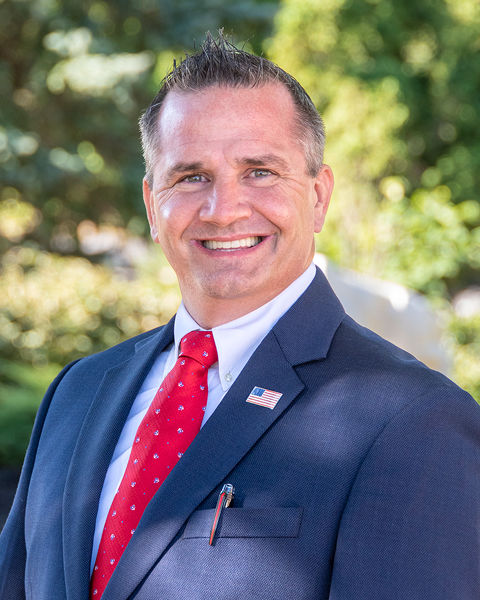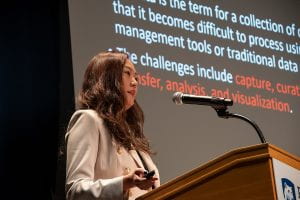Penn State Schuylkill Faculty Research
Penn State Schuylkill’s interdisciplinary researchers solve problems that impact the communities we serve. The research conducted by our faculty and students fulfills one of three pillars of the University’s land-grant mission: to conduct and promote research to improve people’s lives.
The following table lists the notable research activity completed or in-progress by our faculty.
| Researcher Name | Area of Expertise | Research Project Title | Research Description | Keywords |
|---|---|---|---|---|
Dr. Marianne Adam | Nursing | Opioid Addiction: The Experience of Seeking Treatment for a Loved One | This was a qualitative project to investigate the experience of seeking care for for a loved one with a history of opioid use/substance use disorder. | Drug Use, Addiction, Narcotics, Alcohol |
Dr. Marianne Adam | Nursing | Families Forging a Path to Treatment for Opioid Addiction | Survey research, data collected from family members of a loved one with a history of opioid use/substance use disorder. Information collected related to services used, information gathered and the loved one's opioid use/substance use disorder, additional information collected including stigma experience and care of minor children. | Drug Use, Addiction, Narcotics, Alcohol |
Dr. Marianne Adam | Nursing | Registered Nurses Perspectives of Working with People with Substance Use Disorder | Qualitative study examining nurses' perspectives of caring for people with substance use disorder and their families. | |
Dr. Marianne Adam | Nursing | Mapping Key Components of Substance Use Disorder Stigma Awareness/Reduction Education | A scoping review examining educational programs focused on substance use disorder stigma awareness and stigma reduction. | |
Dr. Marianne Adam | Nursing | Towards an Inclusive Pedagogy of Professional Identity Formation in the Health Professions | A descriptive study, survey research examining the impact of a pedagogical activity on professional identity in nursing students, data collected pre and post intervention. | |
Dr. Nicole Andel | English and Humanities | The Shepherd Carolers and the Carpatho-Rusyn Diaspora in the United States (particularly Schuylkill County) and in Transcarpathia. | While looking at presentations of the Shepherd Carolers in Transcarpathia that I found on Youtube, I was surprised to see one with a time/date stamp of 1991. Featuring small children and a Guba that looked like Sasquatch and Chewbacca had produced a child, the play it seemed must have been preserved despite the rabid atheism of the communist dictatorships in the area. Immediately, I thought "how did they manage this?" and "where did this processional come from?" and finally, "Was Christmas somehow responsible for its survival?" Dr. Aurand, who considers how the drama survived in Pennsylvania given the pressure on immigrants to assimilate and to not celebrate religious holidays publically, and I have embarked on a project to collect scripts, images, and interviews pertaining to the Shepherd Carolers and its main character the Guba. Eventually, we want to write a book featuring our findings. | Performing Arts, Lost Art, Music |
Dr. Nicole Andel | English & Humanities | The Shepherd Carolers in the Carpatho-Rusyn Diaspora and Beyond | While looking at presentations of the Shepherd Carolers in Transcarpathia that I found on YouTube, I was surprised to see one with a time/date stamp of 1991. Featuring small children and a Guba that looked like Sasquatch and Chewbacca had produced a child, the play it seemed must have been preserved despite the rabid atheism of the communist dictatorships in the area. Immediately, I thought "how did they manage this?" and "where did this processional come from?" and finally, "Was Christmas somehow responsible for its survival?" Dr. Aurand, who considers how the drama survived in Pennsylvania given the pressure on immigrants to assimilate and to not celebrate religious holidays publicly, and I have embarked on a project to collect scripts, images, and interviews pertaining to the Shepherd Carolers and its main character the Guba. Eventually, we want to write a book featuring our findings. | Performing Arts, Music |
Dr. Harold Aurand Jr. | History | The Bethlehem Carolers | The Bethlehem Carolers is the name of a Christmas processional drama performed by the Carpatho-Rusyns and other Eastern Europeans and their immigrant diaspora in America. Processional dramas were once a common part of many people's holiday celebrations, but most are now gone. Our research focuses on why this ritual has persisted. To do that we have examined the meaning of the play, the role it plays in the communities where it is performed, and how the play helps people understand their place in those communities. | |
Angela Brown, MBA, CPA, CMA | Business | The Production Company - an Activity Based Assessment for Introductory Managerial Accounting Concepts | Through a hands-on team-based approach, students mimicked a production process and were responsible for completion of various managerial/cost accounting reports and calculations throughout the assessment. Observation was used to assess project success. | Business |
Dr. S. Hakan Can | Criminal Justice | Predictors of Violence Reported by Male and Female Inmates. | This study compared predictors of violence as suggested by the importation and deprivation models and the newly utilized threat appraisal and coping models. Participants included 290 female and 472 male inmates in state prisons who completed anonymous surveys to report seven characteristics they import to prison and to report three social stressors experienced during the deprivation and powerlessness of the prison experience. Multiple regression revealed that for both female and male inmates, violence was associated with the imported characteristics of younger age and impulsivity and with in-prison stressors from correctional staff and family. Years of incarceration was a significant predictor of violence only for males. As suggested from past research, the personality pattern of hostility was associated with violence, particularly in male inmates, and internal locus of control was associated with violence, particularly in female inmates. | Crime, Jail, Brutality |
Dr. S. Hakan Can | Criminal Justice | Investigating Factors of Twitter Use among Municipal Governments | This study investigates predictors of Twitter adoption and use by municipalities for citizen communication, considering both the level of municipal Twitter presence and the level of Twitter activity. Possible predictors included municipal characteristics as well as citizenry characteristics. Participants included 100 Pennsylvania municipalities drawn from a disproportionate stratified sample, evenly split between municipalities with and without a Twitter presence. No significant correlation was found between the level of municipal Twitter presence and active use of Twitter. Regression results suggest that the likelihood of adopting a Twitter account increases with greater population size and a younger population, though only population size significantly predicts the number of Twitter accounts. Regression results also suggest that a greater population size, lesser median citizen income, and a higher number of county-level Twitter accounts influence the level of Twitter activity among these municipalities. | Social Media, Online |
Dr. S. Hakan Can | Criminal Justice | Gendered language differences in public communication? The case of municipal tweets | Prior research has shown that gender-based leadership differences can influence organizational functions and behaviour, including strategy, resource allocation, and culture development. It therefore follows that gender- based leadership differences may impact communication. Building on research identifying gendered differences in language use, this study explored Twitter content differences among municipalities in the United States, differentiated by the level of gender-based representation at both the executive (mayoral) and legislative (council/commission) levels. The results uncovered commonly accepted gendered language differences based on may- oral gender, though the influence of council representation partially deviated from accepted differences. The study results form a foundation for larger investigations into gender-based impacts on social media communication and the linguistic styles necessary for maximum engagement. | |
Dr. S. Hakan Can | Criminal Justice | Machismo and Caballerismo Linked with Perceived Social Discrimination and Powerlessness in U.S. Latino Men | Concepts from the Threat Appraisal and Coping Theory, Precarious Manhood Theory, and Ambivalent Sexism suggest that U.S. Latino men who perceive social discrimination and powerlessness may respond with machismo beliefs that serve as coping responses to empower themselves and reassert their manhood. Machismo beliefs include both aggressive “traditional machismo” and gentlemanly family-focused “caballerismo.” Because past research has revealed that individuals respond to social abuse with anger, and anger prompts them to feel empowered but less empathetic, we hypothesized that Latino men who perceive social discrimination combined with a sense of powerlessness would report more traditional machismo and less caballerismo. We also hypothesized that this three-variable sequence would be stronger for men high rather than low in Latino identity because the discrimination would be a more personal threat to their identity and manhood. Participants included 1530 U.S. Latinos who completed online surveys to report demographics (age, education, employment, sexual orientation, partner status, household size), perceived social discrimination, powerlessness, traditional machismo, caballerismo, and Latino identity. Mediational analyses confirmed the three-variable sequence in which powerlessness mediated associations between social discrimination and (more) aggressive machismo, and (less) gentlemanly caballerismo. Also as hypothesized, moderated mediational analysis revealed that these three-variable sequences were stronger for men with high Latino identity. With recent increases in social discrimination against U.S. Latinos, present results caution that men may respond to these challenges with increased aggressive patterns of traditional machismo. | Prison |
Dr. S. Hakan Can | Criminal Justice | Risks and protective factor associated with opiod relapse by relseased inmates supported by "vivitrol" | Another research has initiated to identify life stressors and protective factors associated with opioid relapse show by newly released inmates who received medically assisted therapy in the form of monthly vivitrol injections, starting while incarcerated and continuing for six months after release from prison. Previous research has documented the effectiveness of other medically-assisted therapies (MAT) for improving outcomes for individuals with a history of opioid abuse, with these medications including methadone variates, but our study would be the first to examine opioid outcomes associated with vivitrol injects. Life stressors considered for their association with post-release opioid abuse for the inmates will include transportation problems, housing problems, neighborhood stressors, money problems, health problems, family stressors, partner stressors, “moral injury” stressors, perceived powerlessness, and perceived barriers to opioid resistance. This study will develop and psychometrically evaluate a new Perceived Barriers to Opioid Resistance Scale (PBORS) to identify specific concerns that inmates believe block their success in remaining drug-free after release from prison. This study also evaluating how inmate demographics (age, gender, ethnicity, education, partner status, employment) are associated with risks of opioid relapse during the six months of vivitrol support after release from prison. Finally, we are examining how the inmate’s use of healthy coping behaviors (counseling, social support, exercise, spirituality, creative expression) may serve as protective factors that moderate the impact that their life stressors have on the unhealthy coping behavior of opioid abuse. | |
Dr. S. Hakan Can | Criminal Justice | Measurement and Evaluation of Municipal Social Media: Insight from Front-Line Personnel in the United States | Though social media are widely accepted by governments as strategic communication channels, municipalities often lack the resources necessary to effectively measure and evaluate the impact of social media communication as well as its relationship to strategic goals. This exploratory study investigates how U.S. municipalities utilize social media for strategic communication, focusing on efforts to effectively measure and evaluate that communication. Interviews with municipal personnel show a diverse set of approaches and motivations, with surface-level measurement and evaluation methods. Initial efforts at ad-hoc use of social media channels are slowly giving way to more deliberate strategies, but limited resources are common. | |
Dr. S. Hakan Can | Criminal Justice | Comparison of risk and protective factors on cyberbullying behaviors between rural and urban areas | Identification of risk and protective factors related to school bullying in rural Pennsylvania schools. Local middle and high school students will be surveyed to identify specific risk factors and protective factors that relate to higher and lower levels of school bullying in rural schools. In addition, how school intervention programs in rural schools have impacted bullying behavior over time will be analyzed. | |
Dr. S. Hakan Can | Criminal Justice | Social stressors, personality and coping behaviors associated with male inmate violence | The purpose of this study was to expand available knowledge on predictors of male inmate violence by examining a large set of variables offered by the importation, deprivation and threat appraisal and coping theories. | |
Cathy Fiorillo | Theatre and Speech | Quirks | In our politically divided world, Quirks is the glue that binds humanity together. We all have them , and it is how we navigate those quirks that really matter. This tv pilot follows the protagonist, Cathy as she interacts with her pastor who is quite eccentric, her BFF who thinks he is French, her conscience, which is God and two really not so great dates. All of the characters have quirks and Cathy has the most that she doesn’t see. Mix all of these characters together to have a mad cap and bit farcical comedy. | Theatre, Performing Art, Personalities |
Cathy Fiorillo | Theatre and Speech | SANITIZE THIS! | SANTITIZE THIS! is a short , romantic situational comedy filmed during the Covid pandemic. I was the Screenwriter, Producer, and Actress This film follows the protagonist, Cathy, as she tries to date during a global pandemic. She is hyper neurotic about wearing her mask and gloves while the guy she dates is ultra laidback and the comedy ensues as she tries to navigate this. | Theatre, Performing Art |
Dr. Michael R Gallis | Physics | Interactive Visuals for Physics | This project focuses on crating interactive visualizations (simulations) to enhance student learning in introductory physics courses. Simulations with significant visual information in the form of animations and dynamic graphs are used to help students explore concepts related to lecture and lab. The simulations are created with Easy Java Script Simulations (a free authoring tool) and 20 of the simulations have been accepted for the Open Source Physics project. https://www.compadre.org/osp/search/search.cfm?q=gallis&C=OSP | Education, Learning |
Dr. Michael R Gallis | Physics | Physics Visualizations with Emerging Technology | This project explores the creation and use of more advanced visualization technology (in particular, 360 Video and Web Based Virtual Reality) as applied to topics in introductory physics. | Education, Learning |
Dr. Michael R Gallis | Physics | Novel Laboratory Activities for introductory physics. | Novel laboratory activities can provide students with ways to explore topics that branch off of the “canned” curriculum. Some example topics and activities include: exploring elastic hysteresis in a rubber band “bungee jump” activity, measuring aerodynamic forces via beach ball physics, an automation of a microwave diffraction experiment allowing more data runs in much less time. Many activities are tied in to Easy JavaScript Simulations and use tools such as the Tracker video analysis program. Pasco’s easily customizable equipment and software has allowed tremendous flexibility in creating new activities. | Liberatory Education, Methodology |
Dr. Michael R Gallis | Physics | Animations for Physics and Astronomy | The purpose of the project is to create short animations to enhance student learning on challenging topics in Physics, Astronomy and Mathematics. The animations are primarily 3D visualizations that illustrate complex geometries and processes. All animations are shared via the project's web site and YouTube channel as an Open Education Resource. Currently there are 212 animations available on the project’s YouTube channel, which has had over Six and a half million views. https://www.youtube.com/@mrg3/about | Science, Education, Methodology |
Brian Gardner | Information Sciences and Technology (IST)/Cybersecurity | Addressing the Cybersecurity Issues and Needs of Rural Pennsylvania Nonprofit Organizations | We have developed a cybersecurity assessment process to ascertain key needs and weaknesses with respect to cybersecurity for nonprofits in such rural communities in Pennsylvania. Additionally, this grantsponsored work-in-progress research aims to provide guidance to rural nonprofits with "best practices" and related content that can be easily implemented despite their limitations. | Nonprofit, Survey, Cybersecurity, rural |
Brian Gardner | Cybersecurity | Enhancing Cybersecurity Readiness in Non-Profit Organizations Through Collaborative Research and Innovation | The need for Cybersecurity competence has become a strategic area for all types of organizations, be it large or small, for profit or nonprofit. We use the term competence, but cyber hygiene, cyber competency, cyber resilience and many other terms are relevant to our research focus. Our focus is smaller nonprofit organizations, and particularly those with limited budgets and manpower to address their Cybersecurity issues and needs. Cyber-attacks, such as ransomware attacks, distributed denial of service attacks (DDoS), and phishing attacks wreak havoc on the networks and systems necessary for supporting the populace via services provided by nonprofits. The problems associated with various types of hacks, be it from nefarious individuals/groups or careless internal personnel, are particularly difficult for small to medium nonprofits. We have partnered with the Pennsylvania Association for Non-profit Organizations (PANO) and Penn State receiving the Presidential Public Impact Research Award (PPIRA). We are looking forward to sharing both our lessons learned in the development and evolved methodology that can be used to ascertain key needs and weaknesses with respect to Cybersecurity for nonprofits in Pennsylvania. This project initially sought to determine the current cybersecurity readiness of rural Pennsylvania NPOs. According to the "Center for Rural PA," there are 48 rural and 19 urban counties in which a total of 49,632 NPOs operate across a wide range of objectives and employ 15.7% of the overall population. Research conducted in 2011 indicated that Pennsylvania's rural NPOs were under financial stress, forcing them to significantly cut back on services and operational improvements. While no more current data exists, the effect of the COVID19 pandemic is believed to have increased the level of financial stress on PA NPOs. We are now working with those interested in working with us rather than narrowing the focus to rural non-profits. | |
Dr. Hartmut Heep | English & Humanities | POETIC CLOSETS: GAY LINES AND THE NEW YORK SCHOOL POETS | POETIC CLOSETS: GAY LINES AND THE NEW YORK SCHOOL POETS focuses on John Ashbery, Frank O'Hara, and James Schuyler's homosexuality and their lives in New York City. Ashbery, O'Hara, and Schuyler met because they shared their experiences--and their men--in their poems and their lives. Rather than connecting the writings of these three New York poets with established literary movements of the past, this book length study offers a provocative, prosodic reading that reflects the social, intellectual, political, and sexual views of today. In times of increased social conservatism, these poets suggest different paths of poetic and political resistance to the accepted norms of the 1950s and 60s. | |
Dr. Hartmut Heep | English & Humanities | MACHISMO, MARICONISMO, AND MARIANISMO | MACHISMO, MARICONISMO, AND MARIANISMO is a book-length study at the crossroads of religion, culture, gender, and sexuality. It is a fresh look at the concept of masculinity and femininity in the Hispanic world. At its core is an interdisciplinary journey into the origins of social constructs and normative traditions of men, women, and those in between. Gender identity develops through reinforced behaviors of cultural paradigms. The Latina identity is modeled after the Virgin Mary, whose gender role is validated through the cult of the virgin as marianismo. Hispanic masculinity is based on an elaborate system of behaviors, in short, machismo. The homosexual male, or maricon, threatens the self-referential masculinity concept with his subversive and voluntary rejection of male privileges, a mechanism that I label mariconismo. For the homosexual, gender becomes an individual choice outside of preassigned heteronormative patterns and social expectations. This uber-model proposes fresh gender choices. | |
Anne Mercuri | Human Development and Family Studies | A Tale of Two Mine Fires: Centralia and Tresckow, PA | In 1962, a mine fire was discovered just outside Centralia, PA. During the early 1980s, this community of about 1,000 residents experienced an astounding level of intra-community social conflict over what to do about the mine fire. In 1983, Congress passed a $42 million appropriation to relocate Centralia’s residents and businesses that chose to move. Most residents responded by accepting the government’s offer. Today, fewer than ten residents remain. More recently, in 2012, a mine fire was discovered near Tresckow, PA, about 25 miles from Centralia. Initially causing similar concern, the fire was extinguished without the social conflict found in Centralia. Using document analysis, interviews, and participant observation, this paper examines why this was the case. The paper suggests that three main factors account for the differences in social response: physical differences between the fires; the governments’ responses; and the fact that there was corporate involvement in the latter case. | Graffiti Highway |
Dr. Sarah Princiotta | Biology | Integrating Water Quality and Cyanotoxin Production to Combat Harmful Algal Blooms | Increased frequency and severity of harmful algal blooms is one of the most visible consequences of human-driven changes to the Earth’s landscape. Proliferations of cyanobacteria pose serious risks to water quality worldwide, especially in Northeastern Pennsylvania where 68,000 acres of open water act as a highly valuable natural resource. This is of critical concern given that tourism associated with recreational lakes provide the economic backbone for the region. Although excessive nutrient loading can stimulate a bloom, or prolong its dominance in a waterbody, many other factors make this water quality issue complex and unpredictable. There is a critical knowledge gap concerning the relation between phytoplankton community structure with cyanobacteria abundance, diversity, and cyanotoxin production. This work leverages a regional limnological sampling program to address drivers of toxin production associated with blooms of cyanobacteria. | Algae, High Levels Phosphorus, Lake, Pond, Waterways |
Dr. Sarah Princiotta | Biology | Predator-prey interactions in a green microbial world | Lakes are ecologically and economically important sources of biodiversity that provide an array of ecosystem services. However, proliferations of cyanobacteria, or blue-green algae, are a major threat to water quality on a global scale. Though cyanobacteria are a natural feature of the planktonic community, massive bloom events are exacerbated by anthropogenic activities such as excessive nutrient loading. Toxin production associated with cyanobacteria blooms have garnered attention in the public health realm, as wildlife mortality and human illness have been linked to contact with impaired waterways. To date, much attention has been directed towards abiotic controls of cyanotoxin production through reduction of nutrient input from run-off. However, there is compelling evidence that biotic interactions within the aquatic community may govern the formation and subsequent decay of cyanobacteria blooms. The shortage of information regarding the underlying mechanisms of cyanotoxin production highlight the need for a characterization of biotic regulation of bloom formation. The general objective of this work is to assess and characterize the ability of protistan taxa to provide top-down biological control on cyanobacteria blooms, particularly through biodegradation of cyanotoxins. This is approached through a series of laboratory experiments with aquatic microbes in culture in combination with techniques in microscopy and analytical chemistry. | |
Dr. Lucas J Redmond | Biology | Breeding biology and behavioral ecology of Gray Catbirds | I am an ecologist with particular interest in songbirds. My research focuses on understand aspects of the breeding biology and behavioral ecology of the birds I study. I am especially interested in understanding individual and population level variation in the various ways that parents invest in their offspring. | |
Jason A. Reuscher | Library | Eighteenth Century Recipes: Musings on provenance, ingredients, and the German language from an anonymous recipe collection. | The research project consists of transcribing two, anonymous culinary manuscripts bound as one volume containing 230 recipes written in Kurrentschrift, a form of German Gothic cursive prevalent from the 15th to 20th centuries. The goal is to transcribe the entire manuscript and translate selected recipes to help uncover the provenance of both the manuscript and the recipes. The methods employed in this research include traditional transcription work (an initial syllabary table of characters as well as a glossary of words), but also the use of AI platforms (Transkribus, Claude, and others) to help with transcription, translation, and recipe recreation. Additional historical research into the recipes will also be used to yield clues about their provenance. | |
Jason A. Reuscher | Library | The Syllabary, the Glossary, and AI: Traditional skills and technological advancements helpful in culinary research | Culinary manuscripts are rich in historical value and cultural connectivity, yet because of their ephemerality, many are difficult to access without some understanding of transcription techniques to determine individual recipe contents. This research serves as expository to culinary researchers on both the traditional techniques of the transcriptionist as well as some exciting new opportunities to use optical character recognition and AI to automate some of the process. | |
Jason A. Reuscher | Library | Toward uncovering an anonymous manuscript's provenance: Utilizing language models to discover new connections and insight in an eighteenth-century culinary manuscript | Until recently manuscript transcription has largely relied on the analytical skills of the transcriptionist in assessing orthography and provenance, particularly in anonymous works. Generative AI and language modeling may offer some new insight and analysis into this process, whether it be comparing individual words and recipes within a particular manuscript using a small language modeling process or comparing an entire manuscript to other corpora and their recipes in a large language modeling endeavor. | |
Lisa Robinson | Business | DiscoverSchuylkillHaven.com | A community-based website that creates a platform for connection, knowledge sharing, collaboration, support, and empowerment. It brings people together, facilitates meaningful interactions, and fosters a sense of belonging within a specific community or interest group. | |
Lisa Robinson | Business | Faculty Research Survey and Database | This community-based research project with the theme of mobilizing ideas aims to develop a faculty research database that will serve as a comprehensive resource for sharing research ideas and projects with the potential to impact and benefit the community. The database will consist of unpublished, published, and ongoing research projects that are designed to address pressing societal issues. The project could involve a collaborative effort between faculty members and community stakeholders to possibly identify relevant research topics and establish research partnerships. The database will enable faculty members to share their research findings, publications, and collaborations with the community. This is an interdisciplinary collaboration. | Collegiate Research, Sharing Ideas, Connection |
Dr. Jessica Saalfield | Psychology | Assessing the Alcohol Culture on Small, Rural College Campuses | This comprehensive research project will provide much-needed empirical information about alcohol use and misuse, including addressing the motivators, risk factors, and effects of the Covid-19 pandemic among students attending small, rural colleges. Using community-based methods, the proposed study will utilize semi-structured interviews with students currently attending small, rural colleges to establish foundational knowledge about the drinking culture for this underserved population and will be used to develop a culturally sensitive supplemental alcohol use survey. The survey will be implemented on a large-scale across multiple geographically diverse campuses, producing data that could lead to alcohol prevention and intervention campaigns for students attending small, rural colleges. The goals of the study are to better understand the attitudes, motivations, and behaviors surrounding alcohol at these campuses as well as identify students most at risk for alcohol misuse. | Alcoholism, Alcohol Abuse |
Nancy Schorschinsky | Mathematics and Statistics | Prevalence of active learning methods and influencing factors | In particular, I am interested in the prevalence of active learning methods in introductory STEM courses, the resulting engagement of the students, and the influence of student view of the instructor and student interest in the course on that engagement. I have collected student survey data from about 500 students across Penn State in such courses and am in the process of data analysis. | |
Nancy Schorschinsky | Mathematics and Statistics | Student Use of Effective Study Strategies | Although scientific progress has been made in understanding the most effective learning and studying strategies, myths and misunderstandings seem to persist. I would like to gather an incoming college student's ideas about effective learning strategies to gauge the state of current knowledge on the topic. I survey the students at the beginning of my courses for this information. | |
Nancy Schorschinsky | Mathematics and Statistics | Note aids allowed for exams in remedial and college algebra- ally or foe? | I would like to see the effect that allowing use of a defined amount of prepared notes has on a students ability to perform their best on an exam in remedial and college algebra classes. I am curious about the potential of the presence of the notes to influence the reflection of ability and also math anxiety. I survey the students in my classes at the end of the semester about various aspects of the practice. | |
Dr. Valerie Lynn Schrader | Communication Arts and Sciences | Defining the Soubrette: A Thematic Analysis of the Soubrette Archetype in Classic and Contemporary Musical Theatre | Traditionally, the term "soubrette" referred to secondary light-sounding soprano maidservant roles in opera; however, the term now encompasses a broader spectrum of operatic character types. In this article Valerie Lynn Schrader examines the archetype of the "soubrette" in classic and contemporary musical theatre. Because the soubrette is not clearly defined in these forms, in doing so she seeks to establish the varying characteristics of the type, and to analyze musical theatre characters who are representative examples. Using a list of the longest-running Broadway shows from the popular Broadway fan website playbill.com, Valerie Lynn Schrader has conducted a thematic analysis of fifty-eight "soubrette" characters in thirty musicals. By defining and studying the soubrette, she seeks to provide both theatre scholars and practitioners with a tool for character analysis and performance study. | Performing Arts |
Dr. Valerie Lynn Schrader | Communication Arts and Sciences | Analyzing a Performative Text through Cluster Criticism: Hegemony in the Musical Wicked as a Case Study | This article proposes an extension of Burkean cluster criticism to include performative elements of a musical theatre text. Using the musical Wicked as a case study, this article uses cluster criticism to analyze Wicked’s script, cast recording, sheet music, and fieldnotes from three performances to reveal messages about hegemony. | Performing Arts |
Dr. Valerie Lynn Schrader | Communication Arts and Sciences | “Journey On:” A Rhetorical Analysis of Relational Dialectics in the Musical Ragtime | The dynamic nature of relationships makes them an area of interest for scholars to study. One particular aspect, the contradictions between opposing ideas and their effects, has led to the development of the theoretical construct termed relational dialectics. Although relational dialectics is primarily utilized to study real-life scenarios, it is also applicable to fictional events, such as those in the popular musical Ragtime. Drawing primarily from the research of William K Rawlins (1981, 1992, 2008), we examine the tensions in four relationships within the musical, arguing that the success of the characters' relationships is dependent on the mutual negotiation of inherent oppositions. Through the respective successes and failures of the fictional relationships in the musical, applicable lessons for real life relationships are communicated to audience members. | Performing Arts |
Dr. Valerie Lynn Schrader | Communication Arts and Sciences | “Another National Anthem:” Public Memory, Burkean Identification, and the Musical Assassins | In this article Valerie Lynn Schrader examines the musical Assassins through the rhetorical lenses of public memory and Kenneth Burke's theory of identification. Offering a close textual analysis of the musical's script and cast recording, she argues that Assassins, along with its audiences, serves to co-create a public memory of the men and women who attempted to assassinate Presidents of the United States of America. Her article contends that Assassins creates a chilling consubstantiality between the characters in the musical and theatregoers through Burkean identification, which may cause cognitive dissonance for many audience members. Through identifying key themes in the musical, she argues that these both connect with the assassins' motives and are common human experiences, serving not only to create public memory of the stories, but also to humanize the assassins and create a bond between audience and characters – while the song "Something Just Broke" undermines this connection and encourages audience members to identify with the mourning American public. | Performing Arts, Theatre |
Dr. Valerie Lynn Schrader | Communication Arts and Sciences | Empowerment is Beautiful: Feminism and Post-Feminism in Beautiful: The Carole King Musical | This rhetorical analysis examines the production script of Beautiful: The Carole King Musical through the lenses of second-wave feminism, third-wave feminism, and post-feminism. Based on the life of American singer/songwriter Carole King, Beautiful focuses on the triumphs and tribulations of King's career as a songwriter in the 1960s New York Brill Building, as well as King's personal life, including her relationship with her spouse/lyricist Gerry Goffin. Through this analysis, we explore how Beautiful's characters Carole King and Cynthia Weil embody elements of second and third-wave feminism, and suggest that Beautiful: The Carole King Musical conveys an overall empowerment message that is written for a post-feminist audience, given King's and Weil's empowerment through individual choices rather than through feminist activism. We conclude that this utopian post-feminist message may be problematic for a twenty-first-century audience in that it fails to acknowledge women's current career struggles. | Performing Arts, Theatre |
Dr. Valerie Lynn Schrader | Communication Arts and Sciences | “I Know You:” Burkean Identification and Fun Home’s “Ring of Keys.” | Through a rhetorical analysis of the song "I Know You" in the musical Fun Home's lyrics, cast recording, and sheet music, this essay discusses first how the character of Small Alison identifies with a woman she sees at a diner in “Ring of Keys,” and second, how the song creates Burkean identification between audience members and Small Alison. Finally, the essay contends that “Ring of Keys” is an example of invitational rhetoric, suggesting that, when used through an invitational rhetoric “offering perspective,” Burkean identification, rather than working in conjunction with persuasion, instead can serve to help audience members learn something about themselves. | Performing Arts, Theatre |
Dr. Valerie Lynn Schrader | Communication Arts and Sciences | Broadcasting the Backstage: Essena O'Neill’s Facework as an Instagram Model | This rhetorical analysis examines Essena O'Neill's career as an Instagram model in order to illustrate how Goffman's theoretical construct of facework can be used to study social media and other internet texts. The phenomenon of Instagram modeling emerged as a new forum for aspiring models and marketers in the 21st century. As a public figure, Essena O'Neill's decision to quit the industry of Instagram modeling received a generous amount of media attention. Her newly edited Instagram photograph captions provided viewers with a unique look into what O'Neill portrayed as her backstage persona. In this essay, facework is used to examine O'Neill's comments regarding the "realities" behind her front stage region which was depicted through social media. Although traditionally studied in a face-to-face setting, facework can be applied to an online setting given the internet's ability to allow users to broadcast a front online. Online features such as editing software, a lack of time constraint, and the physical barrier of a computer screen can give users the ability and courage to greatly extend the gap between their front stage and backstage regions, blurring the lines between what can be deemed authentic on social media and creating an entirely new level of front stage. | |
Dr. Valerie Lynn Schrader | Communication Arts and Sciences | “Who Tells Your Story?”: Narrative Theory, Public Memory, and the Hamilton Phenomenon | The popularity of Lin-Manuel Miranda's hit musical Hamilton has been unprecedented. Hamilton tells the story of the first United States Secretary of the Treasury, Alexander Hamilton, a founding father who, until recently, was often forgotten in American public memory. Miranda's unique musical, which fuses an eighteenth- and nineteenth-century story with contemporary music and text, features actors of various races and genders in order to tell the story of "America then" by and for "America now". Through a close textual analysis of the musical's script, cast recording, and sheet music, Valerie Lynn Schrader uses narrative theory to explore how Hamilton creates public memory of one of the lesser known US founding fathers. She argues that, through the narrative paradigm, Hamilton creates what narrative theorist Walter Fisher refers to as "public moral argument",1) through which audience members can discern life lessons, or "equipment for living",2) for their own lives. Finally, the article suggests that the rhetorical theory of Burkean identification may play a role in how public memory of Hamilton's story is formed and how audience members learn life lessons from the musical. | Performing Arts, Theatre, Broadway |
Dr. Valerie Lynn Schrader | Communication Arts and Sciences | Examining the “Histo-remix:” Public Memory, Burkean Identification, and Feminism in the Musical Six | The musical Six has taken the United Kingdom by storm, earning five Olivier nominations in 2019 and crossing the pond, previewing on Broadway in the spring of 2020. Six tells the story of Henry VIII’s six wives in what the musical portrays as their own words, with a twist – the six wives form a girl group performing a concert for their audience. Through a rhetorical analysis of the musical’s script, cast recording, piano/vocal score, and field notes from two performances, I argue that Six creates public memory of Catherine of Aragon, Anne Boleyn, Jane Seymour, Anna of Cleves, Katherine Howard and Catherine Parr, focusing on their individual personalities and accomplishments, rather than simply on their relationship to Henry VIII, as documented history describes them. I suggest that by doing so, Six minimizes the role of place and time in the creation of public memory. Furthermore, I argue that this creation of public memory is intertwined with Burkean identification, as theatregoers find themselves connecting with one or more of the queens as they are portrayed in Six. By combining twenty-first-century language with the stories of sixteenth-century women, Six builds consubstantiality between its characters and its audiences. This article also explores how the final number, Six, reinvents the women’s stories as they might have been if they had lived in the twenty-first century and the impact that this has on public memory. Finally, I suggest that Six is a feminist text, advocating for solidarity and the individually defined empowerment of all women. | Performing Arts, Theatre |
Dr. Valerie Lynn Schrader | Communication Arts and Sciences | “The Most Beautiful Thing in the World:” A Rhetorical Analysis of Relational Dialectics and Friendship in the Musical Kinky Boots | In this article, we examine Kinky Boots, a musical that won the Tony Award for Best Musical in 2013 and continues to win over audiences with its positive message about acceptance, as a rhetorical text through William K. Rawlins’ theoretical construct of relational dialectics regarding friendship. Through rhetorical criticism as a research method, we apply Rawlins’ concepts of political and personal friendships, as well as the dialectics of affection and instrumentality, expressiveness and protectiveness, judgment and acceptance, and the ideal and the real to examine notable relationships between characters in the musical. Specifically, we examine the relationships between Charlie and Nicola, Charlie and Lola, and Don and Lola. Through this analysis, we suggest that when participants in the musical’s relationships fail to negotiate dialectic tensions, their relationships can resultantly cease to exist. We also note that the balance of relational dialectics appears to be conducive to healthy relationships. We posit that Kinky Boots provides theatre-goers with life lessons regarding relational dialectics that they can apply to their own real-life relationships, and that Kinky Boots may serve as an effective teaching tool for undergraduate students learning about relational dialectics. | Performing Arts, Theatre |
Dr. Valerie Lynn Schrader | Communication Arts and Sciences | To Express Oneself or to "Talk Less, Smile More?:" Rawlins' Relational Dialectic of Expressiveness and Protectiveness in the Musical Hamilton | In the musical Hamilton, Alexander Hamilton tests many of his relationships while trying to build a legacy. The relationship he strains the most in pursuit of this legacy is his friendship with Aaron Burr. In this rhetorical analysis, we apply Rawlins’ relational dialectic of expressiveness and protectiveness to Alexander Hamilton’s friendship with Aaron Burr as portrayed in the musical Hamilton. We argue that the tensions caused from the lack of management of the dialectic of expressiveness and protectiveness in Hamilton and Burr’s friendship leads to the loss of Hamilton’s life and the demonization of Burr as a villain. By seeing how Hamilton and Burr’s relationship was strained from their failure to manage the dialectic of expressiveness and protectiveness, audience members can learn how to appropriately trust friends in their lives. We suggest that Hamilton, in this way, provides audience members with what Kenneth Burke describes as “equipment for living,” enabling them to learn life lessons about the dialectic of expressiveness and protectiveness that they can apply to their own relationships. | Performing Arts, Theatre |
Dr. Valerie Lynn Schrader | Communication Arts and Sciences | Public Memory in the Television Series Outlander | Using rhetorical criticism as a research method, Public Memory and the Television Series Outlander examines how public memory is created in the first four seasons of the popular television show Outlander. In this book, Valerie Lynn Schrader discusses the connections between documented history and the series, noting where Outlander's depiction of events aligns with documented history and where it does not, as well as how public memory is created through the use of music, language, directorial and performance choices, and mise-en-scéne elements like filming location, props, and costumes. Schrader also explores the impact that Outlander has had on Scottish tourism (known as the “Outlander effect”) and reflects on whether other filming locations or depicted locations may experience a similar effect as Outlander’s settings move from Scotland to other areas of the world. Furthermore, Schrader suggests that the creation of public memory through the television series encourages audiences to learn about history and reflect on current issues that are brought to light through that public memory. | Performing Arts |
Dr. Valerie Lynn Schrader | Communication Arts and Sciences | The Case for Katherine Howard: Reconstructing Public Memory of Henry VIII’s Fifth Queen through the Musical Six | Katherine Howard, Henry VIII's fifth queen, is remembered because of her tragic death: she was beheaded for having an affair while she was married to the king. Documented history and most popular culture depictions of Katherine Howard have represented her as promiscuous, unintelligent, materialistic, and careless; however, there have been some recent attempts at reconstructing the memory of her as a victim of sexual abuse. In this essay, I explore how the popular British musical Six contributes to the public memory of Howard as a woman who had been abused by the men in her life from a very young age. Through a rhetorical analysis of the script, vocal score, and two performances of the musical, I suggest that Six advocates for a reinterpretation of Howard as an intelligent, capable young woman whose previous sexual traumas influenced her actions and ultimately led to her downfall. I note how this counter-memory of Howard differs from previous depictions in other popular culture texts and in documented history, and I argue in favor of a revised public memory of this maligned historical figure. Finally, I suggest that musical theatre may provide one means of redemption for other historical figures who are remembered negatively due to the context in which they lived, especially those from marginalized communities, through the creation of counter-memories and the recognition of them as victims of their time, place, and circumstances. | Performing Arts |
Dr. Valerie Lynn Schrader | Communication Arts and Sciences | “To Restore the Soul of America:” Religious Rhetoric in Joe Biden’s 2020 President-Elect Victory Speech | On November 7, 2020, after being declared the winner of the 2020 presidential election, Joseph R. Biden delivered his President-Elect victory speech to a crowd in Wilmington, Delaware. Through a generic analysis of religious language in Biden’s victory speech, I suggest that Biden uses religious language in the tradition of American civil religion in an attempt to unify the country after a highly divisive and contested election and to provide hope and comfort in the midst of a global pandemic. While Biden’s address adheres to the themes previous research has associated with the President-Elect victory speech genre, his address appears to utilize religious language more frequently than other victory speeches. I suggest that this is partly due to the unique circumstances in which Biden delivered his address: during a global pandemic, without the concession of his opponent, and at a time when many Americans refused to acknowledge the legitimacy of his election. Because there was no concession speech delivered by his opponent, Biden’s President-Elect victory speech attempted to accomplish all of the objectives usually accomplished by a victory speech working in conjunction with a concession speech. Biden’s decision to utilize “Consoler-in-Chief” rhetoric in his victory speech is also discussed. | |
Dr. Valerie Lynn Schrader | Communication Arts and Sciences | Public Memory, Affect, and the Battle of Culloden: A Rhetorical Analysis of Two Exhibits at the Culloden Visitor Centre | As an integral event in Scottish history, the Battle of Culloden marked the end of the Jacobite Rebellion of 1745, the Scottish clan system, the Stuarts' claim to the British throne, and, in many aspects, the highland way of life. Today, Culloden Battlefield is one of the most visited sites in the Scottish highlands. Tens of thousands of people visit the Culloden Visitor Centre each year to remember the tragic battle. Public memory of the battle brings with it feelings of sadness, mourning, and reflection. Through rhetorical criticism as a research method, I explore how public memory of the Battle of Culloden and the night march preceding it is created through two exhibits at the Culloden Visitor Centre in Inverness, Scotland: the 360-degree Battle Immersion Theatre and the Night March Exhibit. In this essay, I seek to contribute to the understudied assumption that public memory is animated by affect by exploring how emotion is created through these two unique exhibits. Using Wood's (2020) process model of emotional memory synchronization, I argue that these exhibits create an emotion-rich shared experience by engaging audiences through immersive exhibits that utilize sensory elements. Through these exhibits, visitors experience a recreation of what Jacobite soldiers may have experienced during the battle and night march, and this experience creates a connection to the historical events, the soldiers who lived through these events, and the Scottish highlands themselves. I suggest that these exhibits provide an example for how other museums and commemorative sites around the world may wish to use immersive, sensory-laden, and emotion-provoking exhibits to teach audiences about and create public memory of different historical events. | |
Dr. Valerie Lynn Schrader | Communication Arts and Sciences | Sharing “The Music of My Soul:” Invitational Rhetoric in the Musical Memphis | This rhetorical analysis applies Foss, Griffin, and Foss’ concept of invitational rhetoric to the Tony award-winning musical Memphis. The musical depicts multiple conceptualizations of 1950s Memphis through the eyes of a strong, independent Black woman, a rebellious and eccentric white disc jockey, a protective older brother, and a prejudiced mother. While Memphis utilizes the principles of equality, imminent value, and self-determination, and creates external conditions and an offering perspective in order to emphasize the importance of seeking understanding on an individual level to combat racism, it also prioritizes the role of individual responsibility over ending systemic racism. The invitational rhetoric in Memphis provides the audience with different perspectives as four characters tell their stories and create a safe environment in which the audience may feel comfortable reflecting on and sharing their own stories; however, the musical glosses over the impact of systemic racism on the characters’ lives in order to promote a positive, feel-good message. We suggest that while the invitational rhetoric in Memphis may encourage audience members to better understand issues related to race, providing one way of seeking understanding in a society fractured by injustices and polarization, its message is limited due to its lack of focus on the systems in place that contribute to the racism experienced by the characters in the musical. | Performing Arts, Theatre |
Dr. Valerie Lynn Schrader | Communication Arts and Sciences | Through its unique jazz-inspired score, creative sets and costume design, the 2019 Tony award-winning musical Hadestown tells the classic Greek mythology story of Orpheus and Eurydice, in which Orpheus ventures to the underworld to save his love from an eternity of suffering. In this rhetorical analysis of the musical’s script, cast recording, sheet music and Broadway production, I explore how Hadestown makes statements about hegemony and memory that connect with current events. Hadestown presents the underworld as an industrial wasteland that contrasts with Persephone’s green earth, placing industry and the environment at odds with one another and bringing the audience’s attention to issues including climate change, refugeeism, homelessness and poverty. Hades is presented as an industrial tycoon and a hegemon who exploits his workers, and the song ‘Why We Build the Wall’ serves to highlight the many hegemonic tactics used to maintain control over a populace. I also explore how the references to Hades’ wall provide audiences experiencing the musical after 2016 with a biting critique of Donald Trump’s 2016 campaign promise to build a wall to curb immigration at the United States’ southern border, and I suggest that the penultimate song provides audiences with a message that aligns with Hannah Arendt’s view of the purpose of memory: that we must remember the past or, in the words of Hadestown, ‘tell the sad tale’, because we hope that it might turn out differently this time. The messages in Hadestown encourage theatregoers to remember the lessons of history, including difficult memories related to hegemony, because only through remembering can we learn from the past and take the actions necessary to face our current challenges. | Performing Arts, Theatre | |
Dr. Valerie Lynn Schrader | Communication Arts and Sciences | Hidden Figures to Role Model Figures: Liberal Second Wave Feminism, Intersectional Oppression, and Public Memory in the Film Hidden Figures | Using rhetorical analysis as a research method, we analyze the 2016 film Hidden Figures, which is set in the 1960s and centers around a trio of African American women who worked at the National Aeronautics and Space Administration and played a vital role in sending John Glenn to space during the space race between the United States and Soviet Union. In this analysis, we apply the concepts of liberal second wave feminism and intersectional oppression to the experiences of women in the workplace and the exclusion of voices of non-white women in Hidden Figures. We also apply Blair, Dickinson, & Ott’s (2010) six assumptions of public memory to the film, specifically focusing on how public memory allows audience members to observe how memories of past events can bring awareness to present day concerns. In Hidden Figures, viewers reflect on the racial and gender discrimination in the workplace of the 1960s faced by African American women and may be inspired to fight against these same issues of discrimination in the 21st century. Hidden Figures brings to light the lack of African American history stories told in the K-12 history curriculum. Through the stories of Katherine, Dorothy, and Mary, we can learn valuable lessons for the 21st century, such as the importance of advocating for one another. | Performing Arts, Movie |
Dr. Valerie Lynn Schrader | Communication Arts and Sciences | Burkean Identification and the “Ton:” A Rhetorical Analysis of the Netflix Series Bridgerton | Bridgerton, a popular Netflix series produced by Shonda Rimes and based on the novel series by Julia Quinn, has garnered attention, much of which has been positive, for its diverse, color-conscious casting. Differing from the books on which it has been based, the Netflix series includes main characters of various ethnicities, though it maintains its original storylines that often concern issues of class in the Regency era. In this rhetorical analysis of the first two seasons of Bridgerton, we argue that Bridgerton’s success is connected to its ability to create consubstantiality between its characters and viewers. We apply Kenneth Burke’s concept of identification to several characters and storylines throughout the first two season, noting how common ground and dissociation in particular serve to create consubstantiality. Finally, we argue that Bridgerton’s color-conscious casting aids in this creation of identification, even while the series fails to align with documented history of the Regency era and continues to perpetuate classism through its storylines. | Performing Arts |
Dr. Valerie Lynn Schrader | Communication Arts and Sciences | “Talk to Your Doctor:” A Rhetorical Analysis of Burkean Identification in Direct-to-Consumer Pharmaceutical Advertisements | In this article, we use rhetorical criticism as a research method to apply Burkean identification to four direct-to-consumer pharmaceutical television commercials, suggesting that the commercials create a state of consubstantiality with the audience. We contend that the identification strategies of common ground, the assumed “we” through the use of the word “you,” and dissociation are utilized in these commercials to inspire consumers to initiate a conversation with their doctor about their healthcare needs. Based on the success direct-to-consumer pharmaceutical advertisements have had with inspiring patients to engage in a dialogue with their healthcare providers, we argue that Burkean identification could have significant implications when used in other areas of health communication studies, particularly in regards to issues related to the COVID-19 pandemic. We suggest that applications of Burkean identification to health campaigns could increase their effectiveness and cause patient-consumers to be more receptive to the messages being presented. | |
Dr. Valerie Lynn Schrader | Communication Arts and Sciences | “Talk to Your Doctor:” A Rhetorical Analysis of Burkean Identification in Direct-to-Consumer Pharmaceutical Advertisements | In order to better understand the “face” of depression and mental health issues, we apply Erving Goffman’s theory of facework to photographs posted online that people took before attempting suicide. Through the use of rhetorical analysis of participatory photography, we examine Bored Panda’s “50 Photos that Prove Depression Symptoms Have No Face,” an article that consists of a compilation of social media posts in which people used the hashtag #faceofdepression to depict the struggles they themselves or their loved ones have faced with their mental health. Through the application of facework, we argue that there is no one true “face” of depression; depression exists in many different forms and is conveyed or hidden through a variety of different faces. We suggest that looking at social media posts through facework as a rhetorical lens provides a real and unfiltered view of mental health issues and provides a clearer picture of what someone is experiencing from a mental health perspective. Our analysis suggests that people experiencing depression and suicidal thoughts may use conflict front to hide what they are going through from those around them. When people recognize conflict fronts on their friends and loved ones’ social media, they may wish to reach out to these individuals regarding their mental health. The results of this study may encourage individuals to reach out to friends and loved ones who may be in need of help and to work to reduce the stigma associated with seeking help for depression, mental health concerns, and suicidal thoughts and ideations. | |
Dr. Valerie Lynn Schrader | Communication Arts and Sciences | Hoodies, Tattoos, and a Veggie Tray: Burkean Identification and the Fetterman Senate Campaign | In November 2022, Democratic Lieutenant Governor John Fetterman successfully defeated Republican celebrity doctor Dr. Mehmet Oz to become Pennsylvania’s junior Senator, taking retiring Republican Pat Toomey’s open seat. Fetterman was a unique candidate for a number of reasons: At 6’9 with tattoos and donning his signature hoodie and shorts, he didn’t look or dress like a typical politician, and just before the spring primary election, he suffered a stroke, which, while not damaging his cognitive abilities, resulted in a hearing disability. Through a rhetorical analysis of Fetterman’s social media campaign, I argue that Fetterman’s success in the Pennsylvania Senate race was largely due to his use of Burkean identification. I suggest that Pennsylvanians identified with his casual style, meaningful tattoos, and his use of humor via social media, which often involved the use of dissociation, painting his opponent as an outsider from New Jersey who did not understand Pennsylvania or its residents. This paper suggests that future candidates may consider focusing on Burkean identification and its strategies of common ground and dissociation, particularly through humor, in their campaigns. | |
Dr. Valerie Lynn Schrader | Communication Arts and Sciences | “Beauty is Found Within:” Burkean Identification and Inclusivity in Olney Theatre Center’s 2022 Production of Beauty and the Beast. | In November 2022, Olney Theatre Center, a small regional theatre in Olney, Maryland, received national acclaim for their holiday season production of Disney’s Beauty and the Beast. The production featured Jade Jones, a non-binary plus-sized African American actor, in the role of Belle, and Evan Ruggiero, an actor with a physical disability, in the role of the Beast. In this rhetorical analysis of the January 1, 2023 matinee performance, I argue that Olney Theatre Center’s production of Beauty and the Beast successfully re-envisioned the Disney classic to not only be more inclusive, but to enhance the message of the show, focusing on expanding the definition of beauty. I suggest that the performances and casting choices created Burkean identification by establishing common ground with audience members, causing them to be more open to the production’s inclusive message about beauty. Audience members who never saw themselves in either character before may have related to Jones’ and Ruggiero’s performances and may have been more likely to be persuaded of the show’s message that “beauty is found within.” | Performing Arts |
Dr. Valerie Lynn Schrader | Communication Arts and Sciences | Beach Planes, Crudité, and the New Jersey Hall of Fame: Burkean Identification and the Fetterman Senate Campaign’s Use of Social Media | How the Fetterman campaign used Identification in their social media campaigns in order to win the election. | |
Dr. Valerie Lynn Schrader | Communication Arts and Sciences | “You Are More Than Just Your Gift:” Facework and Idealization in Disney’s Encanto | Professor Janelle Gruber and Dr. Valerie Schrader are exploring how messages concerning facework are conveyed in the Disney film Encanto. In this rhetorical analysis, we argue that Encanto provides important lessons regarding facework and advocates for using facework in moderation. Encanto tells the story of the Madrigals, a family who experiences a miracle that results in each member of the family having a special gift – all except for one, the teenage protagonist, Mirabel. When Mirabel recognizes that both the miracle and her family are in danger, she realizes that her individual family members are using facework in order to fit in with the rest of the family and impress the community, even though they feel confined by their gifts. Mirabel’s sisters use idealization to mask feelings of insecurity as well as their own creativity, while her aunt Pepa and cousin Camilo experience difficulties engaging in facework due to the nature of their gifts. Furthermore, Mirabel’s uncle Bruno is shunned by the family because he fails to properly engage in facework. We contend that Encanto provides a cautionary message for its young audience: facework should be used in moderation and that maintaining face, idealization, and front at the expense of expressing one’s emotions can have negative consequences on not only the individual engaging in facework, but also those around them. | |
Dr. Valerie Lynn Schrader | Communication Arts and Sciences | Rhetorical Criticism as a Research Method for Analyzing Musical Theatre Texts | This is a book chapter that will be appearing in Adrienne Hacker-Daniels' "Casting the Art of Rhetoric with Theatre and Drama: Taking Centre Stage" from Lexington Books. It is the lead chapter in the book and focuses on how performative elements such as music, choreography, sets, props, and costuming create rhetorical messages that may or may not align with the messages in the musical's libretto. | |
Dr. Valerie Lynn Schrader | Communication Arts and Sciences | Understanding Christopher: How The Curious Incident of the Dog in the Night-Time Develops Awareness of the Neurodivergent Community | This is a book chapter that I co-wrote with Jessica Neu of Duquesne University. It will be appearing in Adrienne Hacker-Daniels' "Casting the Art of Rhetoric with Theatre and Drama: Taking Centre Stage" from Lexington Books. In this chapter, we explore how the character of Christopher in the play "The Curious Incident of the Dog in the Night-Time" develops awareness of the neurodivergent community. We examine how the play attempts to use sets, lighting, and casting to enable the audience to experience what Christopher is experiencing and explore how different characters' interactions with Christopher raise awareness about neurodivergence. | |
Dr. Valerie Lynn Schrader | Communication Arts and Sciences | Public Memory and "Potpourri:" A Thematic Analysis of Ruth' Plunkett's Column in the Weirton Daily Times from 1976-1994 | This is my sabbatical project. My grandmother, Ruth Plunkett, was a writer and the lifestyle section editor of the Weirton Daily Times throughout the 1970s-1990s. She wrote a popular weekly column entitled "Potpourri: A Medley of Thoughts" from 1976-1994 where she discussed various topics, some of which directly related to the Weirton community. I am in the process of collecting all of the columns in order to conduct a thematic analysis to see which themes arise regarding the community and what we can learn about the community in that time period. I am also working with the Weirton Area Museum and Cultural Center to develop a presentation and/or exhibit on "Potpourri" and my grandmother's career for the greater Weirton area. As I conduct the research, I am keeping an autoethnographic journal with the intent of possibility doing a second autoethnography project later. | |
Dr. Lee J. Silverberg | Chemistry | Synthesis of 2,3-Diaryl-2,3-dihydro-1,3-thiaza-4-ones | We synthesize novel heterocyclic compounds with the aim of finding useful biological activity. Our compounds contain a central six or seven membered ring that includes a sulfur and a nitrogen, an we have discovered a novel reaction for preparing these. Our collaborators have tested a variety of these compounds for antiparasitic, antifungal and antibacterial activity. Some have shown promising activity. | Atom, Elements |
Dr. Lee J. Silverberg | Chemistry | Oxidations of 2,3-diaryl-2,3-dihydro-1,3-thiaza-4-ones | We explore the further conversion of our compounds by oxidation at the sulfur and other atoms. These also may be tested for bioactivity. | |
Dr. Lee J. Silverberg | Chemistry | Assorted Pedagogy | We have published various papers on pedagogical matters. Papers have been about topics such as novel methods used during COVID, technology used in the classroom, research with undergraduates, laboratory experiments, and questions of a theoretical nature. | |
Mary Ann V Smith | Biology | Soil Microbiota and Antimicrobial Discovery | Soil contains many types of organisms living together, which can allow them to have distinct interactions with one another, including the ability of those organisms to produce antimicrobial compounds against other agents. This research uses soil as a resource for microorganisms isolation and characterization. The samples obtained are tested against known bacterial samples for antimicrobial production. | |
Mary Ann V Smith | Biology | Bacteriophage Isolation from Various Soil Types | Bacteriophages, viruses that infect only bacteria, have been used as treatments for infections since the late 19th century. Though replaced with cheaper antibiotics during the 1940s, the potential of bacteriophages to treat today’s antibiotic resistant organisms still remains an untapped resource. This research will isolate bacteriophages from soil and test their ability to infect different types of bacteria. Bacteriophages will be purified and sent for genetic analysis as well. | |
Mary Ann V Smith | Biology | Climate Change Tracking through the Global Learning and Observations to Benefit the Environment (GLOBE) program. | Penn State Schuylkill is part of this international effort to perform environmental/climate monitoring and to help maintain data for our region. In this project, participants will be trained to record data at a site and shared via an international database. The research team also analyzes the data collected on site and across similarly defined sites to take note of patterns of change over time. | |
Mary Ann V Smith | Biology | Medicinal Ethnobotany of the Indigenous Peoples of Pennsylvania | Pennsylvania has had continual settlements for well over 1500 years which has included indigenous peoples for all but the last three centuries. People of the Lenni Lenape and Susquehannock cared for these lands, and used its bounty to help treat their diseases and ailments. Learning more about these plants, including their traditional names along with working to discover their medicinal properties and how may be influenced by phenological cycles can help us understand the heritage of this land, as well as retain traditional ecological knowledge that still remains with these peoples. This study will include interviews with members of the indigenous population about traditional medicinal plants and practices. | Holistic, Organic, Medicine, Greenery, Herbs, Crops |
Mary Ann V Smith | Biology | Medicinal Properties of Traditionally Used Native Plants | Native plants are found throughout Pennsylvania’s landscapes and have been used for medicinal purposes for centuries. Examining the compounds that provided these effects is a foundation of this research. The project also explores whether extracted compound or whole plant influences the compound’s properties. | Holistic, Organic, Medicine, Vegetation, Greenery, Herbs, Crops |
Mary Ann V Smith | Biology | Bioinformatics of Fruit Fly Species | Bioinformatics, a field of biology using databases to examine patterns in genomic sequences, helps determine the function and structure of DNA and protein molecules in organisms. The project examines various fruit fly species for similarities within their fourth chromosome and the particular locations of their exon and intron sites. | |
Mary Ann V Smith | Biology | Phenological Examination of Common Pennsylvania Species | Many plants can survive in different environments, even around a state like Pennsylvania, however how microclimates and climate change influence the life cycle of these plants is still evolving. This project works to track major features of life cycles of native plants (e.g., oaks, maples, witch hazel, blueberries) and commonly introduced/adapted plants (e.g., lilacs). | Vegetation, Greenery, Fruit, Plant Life, Herb |
Mary Ann V Smith | Biology | Storytelling in Science | Storytelling is a traditional way to transfer information. In some content areas, like science, storytelling is often seen as hogwash and not as an important way of communicating. This project aims to counter that perception and train students to use storytelling as their main method for explaining concepts and techniques, for it allows one to use their expertise and give a context. Students have been surveyed as part of several classes utilizing this method to see how they learn to tell stories and what content gets relayed. | Education |
Mary Ann V Smith | Biology | Zoom, Students and Courses (aka, Are You There Students? It’s Me Your Instructor: An Analysis of Student Viewpoints on Zoom in Courses) | Moving to Zoom courses during the pandemic lead to a sea of black boxes that instructors needed to teach to. Many instructors thought that students didn’t care or weren’t attending when the black box appeared, but this instructor felt something else was at play. This research aims to determine why students turn off their cameras and when they do. Students were surveyed since Spring 2021 and within different courses to get perceptions of their interactions with Zoom courses. | Online, Synchronous, Education |
Mary Ann V Smith | Biology | Sourdough Microbiota and Antimicrobial Discovery | Using the age-old tradition of sourdough starter preparation, the different microorganisms found within cultures is examined and characterized. Additionally, the ability of those organisms to produce antimicrobial compounds against other agents is tested. Samples from the sourdough cultures are taken at regular intervals to see microbial development. Microorganisms are isolated for characterization and then these samples are tested against known bacterial samples for antimicrobial production. | |
Dr. Juyoung Song | Criminal Justice | International Self-Report Delinquency Study | The present research will be included Prediction on Delinquency and Recidivism by using Machine Learning analysis in South Korea by using ISRD (International Self-Report Delinquency Study) data. The study will use dataset based on the ISRD questionnaire and questions about experience of youth in juvenile justice facilities in Korea. The crime phenomenon of modern society is more complex and diverse than in the past. There are many ways to predict and analyze crime phenomena. The current era of the fourth industrial revolution is experiencing innovative changes as cutting-edge information and communications technology are incorporated into all areas of the economy and society; for example, artificial intelligence (AI), the Internet of Things, big data, and mobile technology. The discussions of politics, economy, and culture posted on social media outlets represent the opinions of the era. | |
Dr. Juyoung Song | Criminal Justice | Theoretical and empirical reexamination of adolescent delinquency in the fourth industrial revolution society: With big data and artificial intelligence. | The crime phenomenon of modern society is more complex and diverse than in the past. There are many ways to predict and analyze crime phenomena. The current era of the fourth industrial revolution is experiencing innovative changes as cutting-edge information and communications technology are incorporated into all areas of the economy and society; for example, artificial intelligence (AI), the Internet of Things, big data, and mobile technology. Criminologists (crime-data scientists) play a very important role in this process. They create or assemble high-quality data that can be used to train machine-learning systems, find machine-learning algorithms that are suitable for the data, and perform modeling. The discussions of politics, economy, and culture posted on social media outlets represent the opinions of the era. The method of collecting and analyzing the unstructured data from online channels, including the Social Network Service, can interpret the actual phenomenon in our society. The current study uses structured and social big data to predict crime and preemptively respond to it. The result of this study provides a detailed description of the entire research process, which consisted of gathering big data, analyzing it, and making observations to develop a crime-prediction model that uses actual big data. The study also contains an in-depth discussion of several processes: text mining, which extracts useful information from online documents; opinion mining, which analyzes the emotions contained in documents; machine learning for crime prediction; and visualization analysis. Machine learning will be applied to finally suggest a prediction model. The results of the analysis and policy implication will be discussed. | Law Enforcement |
Dr. Juyoung Song | Criminal Justice | Reexamination of ‘Korean Bullying’ using Big Data Analysis and Cross-Comparative Research | As the contemporary phenomenon of school bullying has become more widespread, diverse, and frequent among adolescents in Korea, social big data may offer a new methodological paradigm for understanding the trends of school bullying in the digital era. The study examined a decision tree analysis using social big data to conduct the prediction model on types of risk factors related to cyberbullying in Korea. The study conducted an analysis of causes of cyberbullying and data were collected from online channels, such as news websites, blogs, online groups, social network services, and online bulletin boards. Using opinion-mining method and decision tree analysis, the types of cyberbullying were sorted using SPSS. This approach may contribute to effectively clarifying the problem and suggesting targeted interventions to address the bullying phenomenon in South Korea. Policy implications will be discussed. | |
Dr. Joseph Squillace | Cybersecurity | Utilizing Normative Theories to Develop Ethical Actions for Better Privacy Practices | This study examines the privacy practices of organizations. We argue that successful deployment of privacy practices based on ethical actions will strengthen privacy protection measures to better protect clients’ PII. We propose a set of ethical actions based on six normative theories following multiple case study approach to study three prominent data breaches. Our analysis indicates that ethical actions based on normative theories can be effective in developing better privacy practices for organizations. The theory that has the strongest effect on privacy practices is the deontological approach, while the liberal-intuitive has the weakest effect on privacy practices. | |
Dr. Joseph Squillace | Cybersecurity | A Taxonomy of Privacy, Trust, and Security Breach Incidents of Internet-of-Things Linked to F(M)AANG Corporations | Advancements in technology have brought with it widespread use and utilization of the lnternet-of-Things (IoT); a catch-all moniker identifying the collection of eclectic hardware and software mediums connecting people with small electronic computing and monitoring devices, such as SMART products: television, thermostat, speaker, refrigerator, etc. As personal IoT adaptation has grown in parallel with IoT home integration, so too have IoT concerns related to Privacy, Trust, and the Security risks associated with individual end-user protection, especially from IoT devices linked to Facebook (Meta) (F), Apple (A), Amazon (A), Netflix (N), and Google (G); conversationally identifiable as F(M).A.A.N.G. corporations. As a result, the list of IoT threats, security weaknesses, and vulnerabilities has grown exponentially. Nefarious actors have taken advantage of this growing technology, reaching into homes and offices far beyond established limits set by end-users. This research will use a multiple case study approach to analyze IoT security breach events to identify current Privacy, Trust, and Security risks to end-users associated with IoT devices. Furthermore, this research will also utilize security behavioral research by Anderson and Agarwal to introduce a Safe Computing Practices Model (SCPM) that can be implemented by end-users when integrating IoT devices. | |
Dr. Joseph Squillace | Cybersecurity | Examination of the Financial Relationship Between Overall Stock Market Value and Corporate Investments in Privacy | To better understand why privacy breach incidents continue to occur, this research utilizes Event Study Methodology to examine an area of weakness linked to this phenomenon: corporate investments in privacy. It is argued in this study that a perceived lack of financial value exists to motivate proactive corporate investments in privacy. It is further argued that minimal concern exists for potential financial loss to overall corporate stock market value from privacy breach incidents to motivate reactive corporate investments in privacy. Quantitative analysis of the five-year data sample investigated in this research indicates minimal positive increase in overall corporate stock market value associated with corporate investments in privacy, in parallel with zero presence of long-term financial loss to overall corporate stock market value resulting from privacy breach incidents. This study presents the first known event study research quantifying the financial impact of corporate investments in privacy within the Information System, Assurance, or Cybersecurity domains and disciplines. | |
Dr. Joseph Squillace | Cybersecurity | An Exploration of SETA in Cyber Bullying to Reduce Social Harm & Juvenile Suicide | Cyberbullying is direct action harassment that negatively impacts everyone involved. As a societal concern, cyber-attacks and cyberbullying as a threat remains largely unsolved. Due to the challenging nature of the growing intersectionality between perpetrators, victims, and society, cyberbullying disproportionately affects marginalized individuals and adolescent age children, and continues to have a detrimental impact on juvenile victims, their friends, families, and academic institutions. As a threat, cyberbullying has become weaponized by attackers to target and inflict maximum pain and suffering on victims based on a variety on individualistic differences, including varying social identities, race, age, sexual orientation, ethnicity, gender, and social status. To ensure attack success, the bully in a cyber-attack (cyberbullying) will introduce a series of prolonged, continuous procession of abuse designed to inflict adverse effects on the physical, psychological, and mental health of the victim.Long-term abuse suffered as a direct result of a cyberbullying attack has led to irreparable mental health concerns, challenges in classroom and work activities, victim self-harm, and tragically suicide, regardless of victim age. This unfortunate realization highlights the need for more work to be done to protect our youth. Moreover, the continued misidentification, misclassification, and incorrect definition of what is a cyberbullying attack has led to inadequate and inefficient implementation of effective training solutions and prevention policies to designed to combat cyberbullying concerns, leading to a significant negative impact on victims' overall mental health, well-being, and quality of life. | |
Dr. Joseph Squillace | Cybersecurity | Economic Impact to Overall Stock Market Value from Information Security & Data Breach Events | Technology as a medium is now integrated into every facet of our existence through complex information systems, bringing with it the required infusion of hardware, software, and data. Ensuring the successful implementation of technology, however, requires a dedicated commitment to security. Unfortunately, while Information Protection can be accomplished in a variety of ways, it is evident from recurring security breach incidents that a better understanding of why these events continue to occur is needed. In our research, we will approach the data breach concern from a different perspective; economics [1]. Specifically, we posit that there is not enough economic incentive to motivate companies to sufficiently invest in resources necessary to negate the ongoing threat of data breach incidents [2]. To arrive at a more accurate representation of the overall financial impact of data breach investments, we examine two organizations that address data threats differently: Facebook and Apple. | |
Dr. Joseph Squillace | Cybersecurity | Examining How Targeted Cyber Attacks on Critical Supply Chain Networks Can Lead to Economic Collapse and Civil Unrest | Utilizing Event Study Methodology, this research aimed to better understand the financial implications of critical supply chain disruptions caused by targeted cyber-attacks, and to signify the importance of proactive corporate investments in supply chain security defense. Supply chain attacks have the potential to disrupt critical supply networks, operations, compromise product integrity, and negatively impact critical infrastructure functions. Moreover, supply chain attacks can further cascade into supply shortages, outages, or in some cases, more breaches. Despite the potentially catastrophic consequences of supply chain disruptions, these attacks continue to occur with increasing frequency due to a lack of embedded cyber security controls. Financial Analysis was conducted on supply chain security breach events and attacks from January 1, 2017 - December 31st, 2023 using Event Study analysis to highlight the economic importance for proactive investment in defensive strategies to protect critical supply chains. Moreover, we present the financial impact to corporations using both Parametric and Non-Parametric statistical testing as a result of not investing in the defensive tools needed to protect and secure critical supply chains. Results from this study contribute to the extant body of literature across multiple disciplines, including Cybersecurity, Supply Chain, Critical Infrastructure, and Event Study Methodology. | |
Dr. Joseph Squillace | Cybersecurity | User Vulnerabilities in AI-Driven Systems: Current Cybersecurity Threat Dynamics and Malicious Exploits in Supply Chain Management and Project Management | In today's interconnected digital ecosystem, Artificial Intelligence (AI) and Machine Learning (ML) stand at the forefront of innovation, efficiency, and resource management. However, the rapid ascension of AI and ML technologies that provide a foundation of groundbreaking capabilities need to be protected. Moreover, techniques that make AI and ML effective, efficient, and a force multiplier within the computing domain, and the central tenets of modern AI and ML technological advancement positioning them as the future of tomorrow, need to be safeguarded against exploitation and abuse by threat actors. Based on their ubiquity, embedded use of AI and ML within industry faces a major paradox; as AI and ML technologies empower and streamline operations while providing transformative benefits to users, they simultaneously introduce formidable threats through security vulnerabilities that can cause massive damage if not defended against. This discourse delves into cybersecurity vulnerabilities inherent to AI and ML implementations within critical infrastructure domains of supply chain management and project management to explore how these weaknesses may be exploited. Further, we discuss ways AI and ML can be exploited by cybersecurity vulnerabilities within industry to compromise data and resources. Through a focused, multiple case study, we identify a serious flaw within AL and ML needing further investigation, identify data needing further examination, and isolate specific cybersecurity threats associated with AI and ML in supply chain management and project management, including exploitation of user vulnerabilities, use of AI and ML to bypass security measures, and use of AI and ML to automate attacks. | |
Dr. Joseph Squillace | Cybersecurity | Identifying Security Vulnerabilities and Privacy Risks to Personal Identifiable Information (PII) From a Lack of Consumer Awareness to Common Cyber Threats | As social media as an entity has grown exponentially over the past decade, so too has the individual user base comprising the social media platform across all mediums. However, despite an almost daily deluge of news identifying a new security breach, cyber theft, archive of stolen personal data, exploitative user photos or records, violation of privacy, etc., there remains almost zero concern among individual users to maintain a secure posture when interacting with the Internet, especially social media accounts: predominantly among early age adult students (eg, college-age 18-22). The main objective of this study and the broader impact it will make to society is identification of the most common security threats college-aged students face, isolating why they face these threats, and what is causing college-age students (users) to be so laxed with their security concerns. | |
Dr. Joseph Squillace | Cybersecurity | Advancing Cybersecurity Education Through Evidence-Based Practices That Promote Increased “Cyber Safety” Among Adolescent Technology Users | Exposure to technology at a young age not only influences childhood experiences and development but increases their individual vulnerability to external threats and influences. It is essential for advancing cybersecurity education to both monitor and prepare adolescent technology users in mitigation strategies to eliminate potential threats, while simultaneously protecting our youth. Lazarov et al. (2023) emphasizes the need for cybersecurity awareness during the early-stages of education and proposes a novel methodology that targets high-school and college-age users to promote effective cybersecurity education and awareness through defined teaching strategies. Using evidence-based practices in early education will help foster improved information security maturity. Moreover, adaptation of this novel education model will prepare future cybersecurity workforce personnel to be better positioned in defensive cyber strategies necessary for protecting critical infrastructure and improving our national cyber workforce capabilities. | |
Dr. Joseph Squillace | Cybersecurity | Reducing the Climate Crisis by Decreasing Technology & Computing eWaste: An Examination of User Actions and Behaviors | To better understand how we can help reduce the climate crisis, this research investigation examined user computing activities in detail to analyze and identify eWaste actions causing unknown catastrophic climate degradation. Countless individuals are oblivious to the damage and devastation being caused to the climate by even a single user. As the world becomes more technologically based than ever before, the global impact on the planet has never been greater. This project examines in great detail end-users' normal computer usage to identify where, how, and why they are generating excess eWaste. We argue that the resultant data collected will showcase support for our theory, positing that increasing consumer awareness of better computational practices can lead to positive actions to reduce eWaste.This research study utilized a Multiple Case Study approach to achieve our stated research objectives; recognizing computer actions identified as most detrimental to the climate by level of eWaste (CO 2 e output) and introducing alternative user actions that are ethical, green, and produce less eWaste. In addition to helping reduce the overall user-level carbon footprint and eWaste output, the sustainability of these alternative user actions can be maintained with zero reduction in privacy or security for end- users. Results from this study contribute to the extant body of literature across multiple disciplines, including Privacy, Green Computing, Information System Science and Technology, Cybersecurity, and Sustainable Computing. | |
Dr. Joseph Squillace | Cybersecurity | Examining Cyberbullying Pedagogy to Reduce Juvenile Suicide & Societal Harm | Cyberbullying is an aggressive act or behavior using electronic means repeatedly and over time against a victim that cannot easily protect themselves from the aggressor. Attacks are a varying form of online harassment (Song & Song, 2021) that continues to be a major concern for juveniles. As a complex issue integrating a variety of components, cyberbullying in the education and school system continues to be a growing problem that remains largely unsolved. Due to the challenging nature of the increasing intersectionality between victims, including varying social identities, race, age, ethnicity, and gender (social status). Cyberbullying continues to have a detrimental impact on not only juveniles but also their friends and families. Due to constant misidentification and misclassification, there is equal trouble implementing effective training solutions and prevention policies to address cyberbullying concerns, leading to a significant negative impact on victims' overall mental health, well-being, and quality of life. | |
Dr. Joseph Squillace | Cybersecurity | Privacy Inequality and IT Identities: The Impact of Different Privacy Laws Adoptions | Protecting consumers’ personal information is no longer a by-product of business operations. Since 2018, adoption of General Data Protection Regulation (GDPR) Regulation EU 2016/679 has pushed countries to revamp their data privacy laws and regulations. However, many countries are still l adopting or lack such privacy laws, leading to an inequality in handling users’ data privacy as a fundamental right. We argue that it is possible for users to develop different IT identities with different IT, based on their salient privacy expectations formed by the place where they are interacting with these IT. We plan to apply a mixed methodology for data collection and data analysis. This research will contribute to the current IS literature in a variety of ways by examining how organizations’ compliance and non-compliance to GDPR, as well as better understanding how countries’ adoption and non-adoption of data protection regulations and privacy laws can generate inequality in organizations’ privacy practices. In addition, the study will extend the established IT Identity theory by examining the impact of the data protection regulations in shaping users’ different IT identities and trust. | |
Dr. Joseph Squillace | Cybersecurity | Examination of Corporate Investments in Privacy: an Event Study | The primary objective of any corporate entity is generating as much wealth as possible. Investing financially in technology domains has historically been a successful strategy for generating increased corporate and shareholder wealth. However, investments in Information Technology (IT), Information Systems (IS) and Information Security (InfoSec) to specifically generate increased wealth must be implemented carefully. Shareholders reacting to corporate investments perceive financial value from individual investments. The investment's perceived value is then reflected in the corporation's updated stock market value. IS, IT, and InfoSec investments perceived to possess positive financial value, indicating strong potential for increased wealth, are rewarded by shareholders through increased stock market value; conversely, investments perceived to possess negative financial value, likely to decrease corporate wealth, are punished by shareholders through decreased stock market value. Previous research utilizing Event Study Methodology (ESM) determined financial impact that investments had on corporate stock market value after press release announcements identifying the investment. Based on early success across various domains, additional Event Study Research (ESR) was further conducted within IS, IT, and InfoSec. Most studies aligned into one of three categories: 1) Investments in IT, 2) Information Security Breaches, and 3) IT Outsourcing, and similarly measured changes in market value from corporate investments in related IS, IT, and InfoSec products and services. Examination of the extant body of literature identified a gap within the Privacy domain; minimal ESR examining privacy and the financial impact from corporate investments in privacy. While financial loss associated with a breach incident is identified as the motivating force driving increased corporate investments in defensive measures, "privacy" is identified as a singular construct with little concern for the associated invasion of privacy. As such, little is known about privacy, potential financial risks associated with a privacy breach, nor an understanding of why corporations are not investing in privacy. This research extends the body of literature and makes an academic contribution by: 1) using ESM to identify the financial and overall stock market implications from corporate investments in privacy, 2) identifying the economic incentives motivating corporate investments in privacy, and 3) gaining a better overall understating of corporate investments in privacy, and why corporations are not investing in privacy. | |
Dr. Joseph Squillace | Cybersecurity | Does Legislation on Cybersecurity Standards for Products with Digital Elements Serve Sustainability Goals? In the Context of the EU Cyber Resilience Act Regulation | This study outlines the links between the SDGs and the digital ecosystem and concludes that at least two of the three pillars of sustainable development are definitely affected by the digital ecosystem, i.e. the social and economic pillars are now inescapable. Thus, gender equality, improving the quality of education, social inclusion and equal rights for vulnerable groups can be more effectively ensured through digital skills, but economic objectives such as sharing innovation, capacity building in developing countries, scientific development and cooperation can also be linked to this environment. For this reason, it is now important to define a specific SDG target for the digital ecosystem. This could help to treat the opportunity to connect to the digital environment as a basic human right, which would allow for a better mainstreaming of the SDGs in digital ecosystem legislation. This is also illustrated by the European Union's Cyber Resilience Act Regulation, which supports SDG targets in some regulatory points, but does much more damage by taking less account of the specificities of OSS developers, which in turn can cause significant detriment to other SDG targets and result in extreme detriment to SDGs 12 and 17, ultimately also having a knock-on effect on the social pillar. | |
Dr. Joseph Squillace | Cybersecurity | The Social Impact of Disinformation and the European Union's Response | The great advantage of hybridity, according to Makhmut Gareev, is that the early use of information warfare tools has made it possible to achieve political objectives without the use of military force, by creating controlled chaos through information and other disruptive actions. In extreme cases, this can provoke riots to overthrow an undesirable power structure from within, while smaller-scale scenarios are sufficient to temporarily disrupt the functioning of the state. Gerasimov clarified this in his notorious article by saying that this means primarily the undermining of economic and military potential through informational and psychological influence, even with the active support of the internal opposition. The aim is to destroy the self-organizing capacity of the state. Thus, in many cases, the aim of an attack is to influence the decision-making mechanisms of the country concerned, i.e. in most cases the aim is not to create controlled chaos, but rather to strategically impose. Experience in recent years has shown that social media platforms have not been able to deal effectively with false content that poses a significant social risk, and that their specific business practices amplify the impact of such content. According to the filter bubble theory, internet gatekeepers cause a weakening of social cohesion by making the content that their users like and agree with most visible. These processes threaten democratic institutions, including the integrity of elections. A 2018 US expert report points to a number of possible actions that can be taken to secure elections in European countries as a result of election-related disinformation. These include declaring electoral systems as part of critical infrastructure, improving resilience and conducting regular vulnerability assessments, including mapping legal vulnerabilities and developing possible legal regulation, preparing voters for possible disinformation campaigns, and engaging social media service providers to mitigate potential impacts. Nevertheless, in 2019, there were few states that had legislation to this effect, as the debate was still on whether to regulate or self-regulate to prevent disinformation. The clear consequence of this is that states and non-state actors carrying out information operations on social media platforms can continue to operate successfully to achieve their goals, as unfortunately the Russian-Ukrainian war that broke out in February 2022 demonstrates. In this paper, we examine how such a transformation of the security environment and individuals' attitudes towards the digital environment are linked and how this affects social vulnerability, and how the European Union is trying to respond to this phenomenon. | |
Dr. Joseph Squillace | Cybersecurity | The Impact of Digital Inequality on IT Identity in the Light of Inequalities in Internet Access | As technology has become the bedrock of society and embedded itself into every facet of existence, it is more vital than ever to better understand how technology as an artifact exists in society today. While each new integration of technology has enabled a level of individual success beyond our wildest dreams, there has been a parallel, more insidious realization that needs immediate attention, a darker construct known as Technology Inequality. Spawning from the perspective of direct technology access, a lack of access to technology has introduced an unintended consequence identified as online (in)equality! This phenomenon exists where individual end users experience technology differently, leading to differential development and creation of an online identity, IT Identity, based on technology access, education, and exposure. In academic parlance, Technology Inequality describes a developmental stage of technology fusion that begins at an early age and continues over time as individuals age. Negative consequences begin with reduced/limited access to physical technology, often due to factors beyond an individual’s direct control, and ends with users having reduced Internet Access, causing the individual to create an online persona known colloquially as IT Identity. Together, the intersectionality of Technology Inequality and IT Identity isolates the burgeoning gap in socioeconomic factors among users with, and without, Internet access; including education, income, and lifestyle. | |
Dr. Joseph Squillace | Cybersecurity | The Financial Impact of Cyber-Attacks: Comparative Study on the Manufacturing and Service industry | This research investigation utilized Event Study Methodology to better understand the economic implications from disruptions to critical supply chain infrastructure resulting from targeted cyber-attacks. More specifically, this project examines in depth the financial impact to organizational stock market value stemming from cybersecurity breach incidents to organizational assets. While supply chain attacks possess the potential to disrupt critical supply networks, compromise product integrity, and negatively impact critical infrastructure, these attacks continue to occur with increasing frequency due to a lack of accountability to organizations tasked with implementing embedded cyber security controls to thwart such attacks. Financial Analysis was conducted on supply chain security breach events and attacks during a five-year period: January 2017 – December 2023 using Event Study analysis. As this research investigation extends previous work, we focused specifically on comparing new security breach events from the two most targeted Standard Industrial Classification (SIC) divisions as identified by Security Exchange Commission (SEC) classification – Division I (Services) and Division D (Manufacturing). Once identified, the collected previously not studied, was then compared to assess the individual organizational economic impact relative to the overall sample identified. Results indicating the realized economic impact to corporations are presented using both Parametric and Non-Parametric statistical testing and showcase in numerical values the financial results of the security breach. Results from this study contribute to the extant body of literature across multiple disciplines, including Cybersecurity, Supply Chain, Critical Infrastructure, and Event Study Methodology. The updated research investigation assesses the financial impact from data and cybersecurity breach events on additional industries not examined in previous research. This new resultant data yield not only contributes to advancing our understanding of the financial impact from security breach events, but better provides more information about why companies in specific industries and domains are, or are not, investing in cybersecurity defensive strategies. | |
Dr. Joseph Squillace | Cybersecurity | Lessons Learned from Using Cyber Range to Teach Cybersecurity at Different Levels of Education | In today’s modern society, it is difficult, nearly impossible, to work or study effectively without using the internet. With services moving into cyberspace and the ever-increasing number of users, new cyber threats are emerging whose impact can be devastating to organi- zations or individuals. For this reason, it is necessary to educate users regardless of their age, gender, and qualifications. This paper addresses the challenges associated with the need for cybersecurity education and presents lessons learned from applying interactive and gamified approach within the cyber range (CR) to teach cybersecurity at different levels of education. Through a series of tests, different use cases, and feedback collected from students and teachers, we identified their perceptions and critical aspects of CR-based cybersecurity education. These findings may be useful for building and further developing cyber ranges to improve the effectiveness of cybersecurity learning and training. | |
Dr. Joseph Squillace | Cybersecurity | Modernizing Hungary's Cybersecurity Framework: Addressing Evolving Threats and Enhancing National Resilience | Ensuring the security and protection of citizens in a democratic society requires a comprehensive and adaptable national cybersecurity strategy. This strategy must address the dynamic and evolving nature of cyber threats from state actors, criminal organizations, and individual hackers. For EU Member States, continuous development and modification of cybersecurity policies are essential to counter these threats effectively. Hungary's current cybersecurity strategy, based on principles established in 2013, has become outdated and insufficient in addressing modern hybrid threats and the critical role of non-state actors. To enhance Hungary's cybersecurity framework, it is crucial to develop a new strategy that integrates with other sectors, eliminates redundancies, and reflects updated security principles. This strategy should focus on enhancing digital competence, promoting civil-state cooperation, and fostering a culture of security awareness among the general public and private sector. By aligning with EU standards and leveraging international collaboration, Hungary can improve its preparedness against cyber threats and ensure a secure digital environment. Implementing these principles will contribute to a resilient and secure digital ecosystem, essential for economic stability and the protection of citizens' rights and freedoms. | |
Dr. Ping Wang | Mathematics and Statistics | Applied Mathematics | Heat conduction, analytical fractals | Math |
Dr. Gina C. Whalen | Business | Life Experience: An analysis of knowledge transfer through internship in an online business program | This is a scholarship of teaching and learning study that seeks to analyze the outcomes of internship experiences facilitated through an on-line program. The study will assess student learning outcomes, both cognitive and non-cognitive, as reflected in their responses to a series of pre- and post- survey questions; as well as an evaluation of the artifacts they generate as part of an on-line internship course. | Asynchronous, Online Education |
Dr. Gina C. Whalen | Business | Bonded from Brokenness: A Collaborative Autoethnography on Maternal Bereavement | The purpose of this study is to explore the experience of maternal bereavement. As scholar practitioners the authors offer their personal narratives to bring awareness to the multifaceted aspects of grieving the death of a child. Using collaborative autoethnography as the study’s methodology enabled the authors to explore their connection to the sociocultural context of maternal grief. | |
Dr. Gina C. Whalen | Business | The Super-vision of Autoethnographic Dissertation Studies: Transformative Stories of the Supervisor and the Supervised Revealed | The purpose of this research is to explore the supervision of dissertations, from the perspective of the supervisor and two supervisees who did dissertations that had an evocative autoethnographic component. Our collaboration highlights ways in which we’ve offered super-vision to each other (often unknowingly) in different aspects of our lives. We have also analyzed how we’ve developed a greater understanding of Transformative Learning as grounded in the visceral, the spiritual, and the relational that are intricately connected to the Big Questions of Love, Death, and life purpose. | Storytelling |
Dr. Gina C. Whalen | Business | Using Autoethnography, Storytelling, and Metaphors to Explore the Traumatic and Transformative Journeys | The study was designed to address ethical concerns that typically arise when representing or appropriating others’ traumatic experiences and vulnerable populations. It empowered my sisters-in-loss to give voice to their heartbreaking and often-stigmatized experience. A combination of a narrative inquiry and autoethnography were utilized. |


